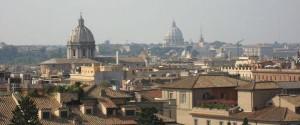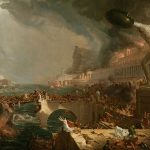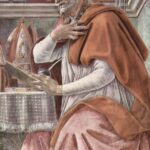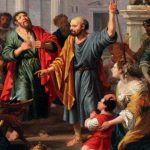Rome, Caesar, Christ and Eternity
Rome is known as the Eternal City, and probably for good reason. Founded over two and three quarter millennia ago, it is obviously still going strong. I should know, since I am there right now, and have the sore legs to prove it! And since I have an interest in both history and Christianity, it is worth writing about. So let me take a few minutes off from sightseeing and write this piece.
 If you want to find a place with a lot of history, terrific architecture, and moving artwork, Rome of course is hard to beat. We managed to duck into four basilicas just today, and they were all overwhelmingly majestic and beautiful. Such was the inspiration of the Christian faith that such monumental churches could be built.
If you want to find a place with a lot of history, terrific architecture, and moving artwork, Rome of course is hard to beat. We managed to duck into four basilicas just today, and they were all overwhelmingly majestic and beautiful. Such was the inspiration of the Christian faith that such monumental churches could be built.
And believe it or not, we also managed in our whirlwind tour to check out some other amazing places. Let me discuss just two of them.
Pantheon
This very famous structure was established around the time of Christ, and was originally a temple to the various pagan gods. It was pretty clever how they dealt with religious pluralism back then. When the ancient Romans conquered a people, instead of telling them to stop worshipping their god, they simply added it to their collection of deities.
As the name suggests, this was a place of ‘all gods’ or ‘many gods’. Everyone could be happy, as an image of their particular god was added to the Pantheon. As long as the Roman ruler had pride of place in worship, they could keep their gods. But when Jesus Christ came on the scene, things became real messy.
He did not proclaim himself as just another god, but as the One True and Only God. And the early Christians saw him as Lord exclusively. That meant that the other gods, and emperor worship, were just not on. That of course was a major threat to the powers that be at the time.
To proclaim Jesus as Lord was to say that the Emperor was not. That was treasonous, and of course plenty of Christians paid the price as a result. This was not just religious disloyalty, but more importantly, political disloyalty, and a threat to the whole Roman Empire.
So believers back then had to make a very clear choice as to who they would serve as Lord. Those who did not bow to Caesar had to pay the ultimate price – and many did. Of course later, when Emperor Constantine converted to Christianity around 312, the scene slowly turned around, and by the 7th century the Pantheon was turned into a Christian church.
Colosseum
The other remarkable structure we visited was a building built around 72-80AD. An amazing structure, certainly when it was built and still today, the Flavian Amphitheatre could hold 50-70,000 spectators. The oval-shaped field where the gladiatorial contests and other spectacles took place was around 180 by 150 metres, with the stands rising some 50 metres high.
It certainly rivals an arena such as the Melbourne Cricket Ground, and is far more spectacular and beautiful – even 2000 years on. It was a place not just of entertainment, but of political significance. The rulers knew that they could keep the masses contented and pacified if they kept the bread and circuses going.
So the grisly entertainment which killed so many went on for several centuries, until Constantine also put an end to all the blood sport. It seems that historians are now not so certain if the early Christians were persecuted and killed in the Colosseum, but we do know that Rome did see its fair share of Christian martyrs. Nero for example was an early and avid persecutor of Christianity.
The real eternal city
But as much as the Roman rulers sought to stamp out the pesky Christian religion, it was the latter which survived. While the old Roman Empire is no more, Christianity has continued on, and has not just outdone the old Empire, but is of course a global religion which shows no signs of disappearing as so many old empires have done. Human empires come and go, but God’s reign and rule goes on forever.
One day this famous Eternal City – as beautiful as it still is – will come to an end. But our Heavenly City will abide forever. Some 1600 years ago Augustine wrote his famous The City of God. In it he contrasted the City of God with the City of Man. All human empires will one day come to an end, while God’s empire will rule eternally.
And all because of one man who walked the earth 2000 years ago. Jesus Christ is the only true King, and the two millennia-old Christian church has seen many earthly powers wax and wane. And when all the glories and splendour of earthly civilisations have long gone, the glorious Kingdom of our God will still abide.
Long ago the Apostle Paul was holed up in Roman custody, but he still wrote some incredible epistles during this time, which are still read today by millions. While we can walk where the ancient Caesars once walked, we can also breathe the spiritual air that Paul breathed so long ago.
A city like Rome is beautiful almost beyond description, but when this world is no more, and the New Heavens and the New Earth are unveiled, our true Eternal City will make Rome seem like a mere rubbish dump. All because of King Jesus.
He did not come to earth the first time as a conquering king, but as a humble servant, who died at the hands of the military powers of the day. But unlike any Emperor or any Caesar, Jesus rose again, and as a result, as Paul in Philippians 2:9-11 says:
“Wherefore God has also highly exalted Him, and given Him a Name which is above every name: that at the Name of Jesus every knee shall bow, of things in heaven, and things in the earth and things under the earth; and that every tongue should confess that Jesus Christ is Lord, to the glory of God the Father.”
I will continue to very much enjoy the remarkable city of Rome, Italy. But one day I will far more enjoy the Heavenly City which I, and all those who make Jesus Christ Lord, will dwell in forever and forever.
[1065 words]




















When Jesus Christ rode into Jerusalem on Palm Sunday it was not to the city of Jerusalem that he had come to liberate from the Romans. He came to clean out the temple.
Many religious leaders today are also centred on redeeming the city, rather than building the temple, the body of Christ. Many of them are linking up with Rome to create a Kingdom here on Earth, ruled by the anti- Christ.
http://www.newcalvinist.com/kellers-affinity-with-rome/
David Skinner UK
Beautiful thoughts Bill. Have a glorious holy Easter and come back soon! x
“But one day I will far more enjoy the Heavenly City which I, and all those who make Jesus Christ Lord, will dwell in forever and forever”
Thanks Bill. The very same city that Abraham and countless other saints looked for – whose builder and maker is God.
Amen to your comment and the biblical perspective that Rome inspired!
Augustine’s exposition of the essential differences between the City of God and the City of Man is to my mind the vital antidote to Thomas Aquinas’ schism of human affairs into secular and spiritual domains.
Aquinas’ idea, which was built on a synthesis of Aristotelian philosophy and Christian theology proved to be the beginning of the secularization of Western culture: At length, theology was demoted from its late medieval status as “queen of all sciences” to its present position as a “poor ‘country cousin’ of the physical sciences”.
Mainstream Western man now has effectively lost faith in both God and humanity. What is liberating about “human puppets” dancing to the tune of their allegedly ever-evolving DNA?
I like how you talk of “many gods”. After all as we see in Acts, idol manufacturing was big business. For all its gods, the Roman Empire was godless and driven by greed and lust (especially for money and power).
For all its grandeur, Rome is not Jerusalem. And whatever the English may sing, Jerusalem isn’t in England either.
The Heavenly City has a name Jerusalem, and yet it will come down to Earth and we will live in it in physical bodies.
The Hebrew way of thinking where the physical and spiritual are connected is very much present in the New Testament, no more so than in the Incarnation of the Messiah, his death, burial, resurrection, ascension and return.
The New Jerusalem will make any city in the world today look like a rubbish dump.
But ultimately it is not the city that is most important it is God’s presence. The temple rebuilt after the exile may not have been as grand as the first but that was not what mattered to God.
Indeed it will be the pure light radiating from God that will give the city its beauty. Science tells us that the precious stones of the New Jerusalem under pure light go into all the colours of the rainbow whereas noticeably absent stones such as diamonds look dull under pure light. The selection of stones is strong evidence for the reliability of the Book of Revelation.
Rome may well have been the Babylon of the Roman Empire, but what the Babylon of the future will be remains unclear.
Have a great holiday Averil and Bill
Love from us both